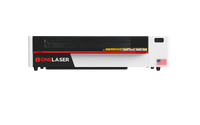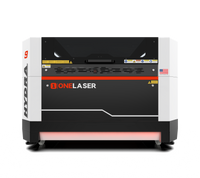Choosing the right material is critical for success when working on a laser engraving plastic project. Not all plastics respond the same way to laser energy, some engrave with crisp edges and polished cuts, while others melt, discolor, or release harmful fumes. Poor material choice not only reduces quality but can also damage equipment or compromise safety.
Key Takeaway
This guide explains how to identify the best plastic for laser engraving and cutting, highlights which plastics to avoid, and shows how to pair the right material with machines such as the OneLaser X Series and Hydra Series for optimal performance.

1. Types of Plastic Materials Used in Laser Engraving
For professional results, you need to know how lasers affect plastics. Different types of plastics have different melting points, burning characteristics, and optical properties. These differences affect the clarity of the engraving, the smoothness of the edges, and the durability of the final product.
Polymers that etch with sharp contrast and polished edges are good for signs, nameplates, and decorative work. Others don't react well, which can lead to bad smells, burns, or melted surfaces that make things less safe and less good. Knowing which polymers are safe for lasers and which ones aren't helps you get cleaner results and work more safely.
1.1 Suitable Plastics for Laser Engraving
Acrylic (PMMA):
Acrylic is widely regarded as the gold standard for laser cut plastic sheets. Available in clear, frosted, and colored varieties, it responds exceptionally well to laser energy.
Vector cutting produces smooth, flame-polished edges, while raster engraving creates sharp, high-contrast marks.
Acrylic is particularly valued in signage, displays, awards, and decorative applications where optical clarity and edge quality are essential.
PETG (Polyethylene Terephthalate Glycol-Modified):
PETG combines durability with ease of processing. Unlike acrylic, it is more impact-resistant and less brittle, making it useful for prototypes and functional parts. PETG engraves with moderate contrast and cuts with a clean, slightly frosted edge.
While it doesn't polish as smoothly as acrylic, it is preferred in industrial and engineering contexts where toughness is more important than appearance.
Polypropylene (PP) & Polyethylene (PE):
These plastics are lightweight, flexible, and chemically resistant. They don't engrave with the same crispness as acrylic, but they are suitable for industrial uses such as packaging, containers, and functional parts. Because of their lower melting points, careful power settings are required to prevent warping or rough edges.
They are best suited for vector cutting simple shapes rather than fine-detail engraving.

1.2 Plastics to Avoid
PVC (Polyvinyl Chloride):
PVC should never be used in laser engraving or cutting. When exposed to laser energy, PVC emits chlorine gas, which is toxic to humans and corrosive to machine components.
Even small amounts of PVC can cause permanent machine damage and pose serious safety hazards.
Polycarbonate (PC):
Polycarbonate is technically engravable, but it produces poor results. It tends to discolor, bubble, and char under laser heat, making it unsuitable for professional applications. In addition, the fumes it releases are unpleasant and difficult to filter.

1.3 Comparison Chart: Plastics in Laser Engraving
|
Plastic Type |
Laser Engraving Quality |
Cutting Finish |
Durability |
Fume Safety |
Best Applications |
|
Acrylic (PMMA) |
Excellent contrast, crisp detail |
Flame-polished, clear edges |
Rigid, brittle |
Clean-burning |
Signage, displays, awards, decorative items |
|
PETG |
Moderate contrast, good detail |
Clean but frosted edges |
Strong, impact-resistant |
Safe, low fumes |
Prototyping, protective covers, functional parts |
|
Polypropylene (PP) |
Fair, low contrast |
Flexible edges, risk of warping |
Flexible, chemical-resistant |
Safe |
Packaging, industrial components, containers |
|
Polyethylene (PE) |
Fair, low contrast |
Similar to PP, cuts clean with care |
Flexible, lightweight |
Safe |
Prototypes, industrial use, packaging |
|
PVC |
Unsafe – toxic fumes |
Unsafe |
Durable but not laserable |
Hazardous |
Not suitable |
|
Polycarbonate (PC) |
Poor – burns and discolors |
Rough, charred edges |
Strong but engraves poorly |
Problematic fumes |
Not recommended |
2. Key Factors When Choosing the Best Plastic for Laser Engraving and Cutting
Not all plastics perform the same way under laser processing. Each material reacts differently to heat, energy absorption, and airflow inside the machine.
Selecting the wrong type of plastic, or ignoring its physical properties, can lead to poor edge quality, inconsistent engraving, machine contamination, or even safety risks.
To achieve professional, repeatable results, laser cut plastic sheets should always be evaluated based on four critical performance factors:
2.1 Thermal Resistance
The most important property in laser processing is how well a material resists localized heat. Plastics with high thermal resistance can withstand laser energy without excessive melting, sagging, or distortion.
This is especially critical when cutting thin sheets where heat buildup can warp the material.
- Acrylic handles laser heat very well, vaporizing cleanly without deformation.
- Polypropylene (PP) and Polyethylene (PE), on the other hand, soften quickly at relatively low temperatures, requiring careful adjustment of power and speed.
- Choosing plastics with stable thermal performance minimizes wasted stock and ensures tighter dimensional accuracy.
2.2 Edge Finish Quality
The quality of the cut edge is a key performance measure, particularly for signage, displays, product housings, and consumer-facing applications.
A smooth, polished edge enhances the final presentation, while rough or melted edges often require secondary finishing.
- Acrylic (PMMA) produces flame-polished edges straight from the laser—no sanding or buffing required.
- PETG cuts cleanly but typically leaves a slightly frosted edge rather than a polished one.
- Softer plastics like PP/PE may produce rough or stringy edges if settings are not carefully controlled.
For any project where aesthetics matter, edge finish is often the deciding factor in material selection.
2.3 Optical Clarity
For transparent plastics, especially acrylic, optical clarity is crucial. The way a laser interacts with clear or frosted surfaces determines how light diffuses through the final product.
- Clear acrylic is ideal for backlit signage, edge-lit panels, awards, and displays, as it refracts light evenly.
- Frosted or colored variants diffuse light differently, offering more creative control for design projects.
- Materials like PETG offer good strength but don't achieve the same crystal-clear polish, making them less suitable for illuminated or decorative applications.
Choosing the correct clarity level ensures that engraved designs not only look sharp but also interact with lighting in predictable ways.
2.4 Fume Profile
Every plastic emits some byproducts during laser processing, but the type and severity of fumes vary widely. Understanding a material's fume profile is critical for both safety and maintenance:
- Acrylic is a clean-burning plastic, releasing mainly carbon dioxide and water vapor, with manageable levels of fine particulate.
- PETG, PP, and PE produce low-to-moderate fumes but require effective fume extraction to maintain a clean workspace.
- PVC is strictly unsuitable—it releases corrosive chlorine gas that damages machine optics, corrodes metal components, and poses severe health hazards.
- Poor fume management not only reduces operator safety but also shortens machine lifespan by increasing residue buildup inside the optics and fans.
By weighing plastics against these four factors, thermal resistance, edge finish quality, optical clarity, and fume profile, users can make informed decisions about which materials deliver the best balance of aesthetics, durability, and safety. Careful material selection minimizes rework, extends machine life, and ensures consistently professional results.
3. Best Laser Engraver to Laser Cut and Engrave Plastic
Not all laser machines interact with plastics in the same way. The choice of equipment directly impacts edge quality, engraving depth, processing speed, and long-term repeatability.
When working with plastics, the best results come from pairing the material's properties with the machine's capabilities.
Two systems stand out for plastic engraving and cutting applications: the OneLaser X Series and the Hydra Series.
3.1 OneLaser X Series – Precision Engraving at Small Scale
The OneLaser X Series is engineered for applications that require high-resolution engraving and controlled material handling.
- Precision Optics: Delivers fine spot sizes that allow for micro-scale text, intricate vector graphics, and crisp logos.
- Optimized for Acrylic: Especially effective on clear, frosted, or colored acrylic sheets, producing flame-polished edges and high-contrast engraving.
- Thin Material Handling: Designed for thin plastic sheets (under 4mm), preventing distortion and ensuring consistent engraving depth.
- Compact & Flexible: Well-suited for smaller projects such as labels, product tags, prototypes, nameplates, and decorative etching.
- High-Resolution Output: Functions as a high resolution desktop laser engraver, making it ideal for applications where sharp detail is non-negotiable, such as product personalization or branding.
Explore the OneLaser X Series!

3.2 Hydra Series – High-Power Cutting and Production Efficiency
The Hydra Series is designed for users who need to process thicker plastics and larger sheet formats at production scale.
- High-Power Capability: Cuts through thicker acrylic and other laser-safe plastics (4mm+) in fewer passes, improving throughput.
- Batch Production Ready: Engineered for continuous operation, making it suitable for signage shops, fabrication facilities, and industrial-scale production.
- Durable Mechanical Design: Built to handle heavy-duty workloads without compromising engraving precision.
- Versatility Across Plastics: Handles a wide range of laser cut plastic sheets, from cast acrylic for signage to PETG for functional prototypes.
- Clean, Polished Edges: Even at high cutting power, the Hydra maintains smooth, polished edges that minimize the need for secondary finishing.
- Efficiency-Oriented: Reduces setup adjustments between jobs, helping maintain faster turnaround times in busy production environments.
Discover the OneLaser Hydra Series!

3.3 Choosing the Right Machine for Plastic Engraving
- For high-detail engraving, labels, and decorative small-scale work, the OneLaser X Series provides unmatched clarity and precision.
- For thicker sheet cutting, signage, and industrial production, the Hydra Series offers the power and throughput needed to meet demanding workloads.
By matching the plastic type and project scale with the right system, users can maximize engraving quality, minimize rework, and achieve consistently professional results across both one-off projects and full-scale production runs.
4. Best Use Cases for Laser Engraving Plastic Materials
Different plastics serve different creative and functional needs. Here are some of the most effective applications:
- Acrylic Signage – Custom-engraved logos, lettering, and panels with polished edges.

- Prototyping Components – PETG, PE, or PP components for product development, particularly when flexible or impact-resistant properties are required.
- Product Labels & Nameplates – High-resolution vector engravings for durable plastic identification tags.
- Backlit Displays – Reverse-engraved acrylic panels that create illuminated effects for retail and decorative use.
Each application benefits from selecting the best plastic for laser engraving and cutting, tailored to material behavior and project goals.
Subscribe Our Youtube Channel!
5. Tips for Laser-Safe Plastics
Safe handling and proper storage of plastics play a major role in long-term engraving quality:
- Store Flat in Controlled Conditions: Keep plastic sheets in dry, shaded environments to prevent warping or UV degradation.
- Label All Material Types Clearly: Prevent accidental use of PVC or other unsafe plastics.
- Ensure Proper Ventilation: Even laser-safe plastics release particulates. Use adequate fume extraction systems to protect both users and equipment.
- Use Filtered Extraction Systems for Large Jobs: Processing larger laser cut plastic sheets produces more fumes, requiring advanced filtration to maintain safety standards.
Following these practices protects both operators and machines, ensuring consistent engraving results.
6. FAQs
1. What is the best plastic for laser engraving?
Acrylic is widely considered the best due to its clean engraving contrast, polished cut edges, and versatility across applications.
2. Can you laser engrave PVC safely?
No. PVC releases toxic chlorine gas that is harmful to both users and machines. It should never be processed with a laser.
3. What resolution works best for plastic engraving?
For detailed work, 600 DPI or higher provides excellent results. For large designs or cutting jobs, 300–400 DPI balances speed and quality.
4. Which machine is better for thick plastic sheets?
The Hydra Series, thanks to its high-power capabilities, is ideal for cutting and engraving plastic sheets thicker than 4mm.
5. Do different plastics require different laser settings?
Yes. Material density, melting point, and surface finish affect power, speed, and resolution requirements. Testing small samples first is recommended.
Have Questions? Join Our Forum!
Conclusion
The success of any laser engraving plastic project depends on careful material selection, machine optimization, and safe working practices. By choosing the best plastic for laser engraving and cutting—such as acrylic, PETG, or PE—and pairing it with the right machine like the OneLaser X Series or Hydra Series, users can achieve professional-quality results.
Smart planning reduces rework, extends machine life, and produces cleaner, more reliable engravings and cuts across a wide range of applications.

 Liquid error (sections/image-banner line 171): invalid url input
Liquid error (sections/image-banner line 171): invalid url input






